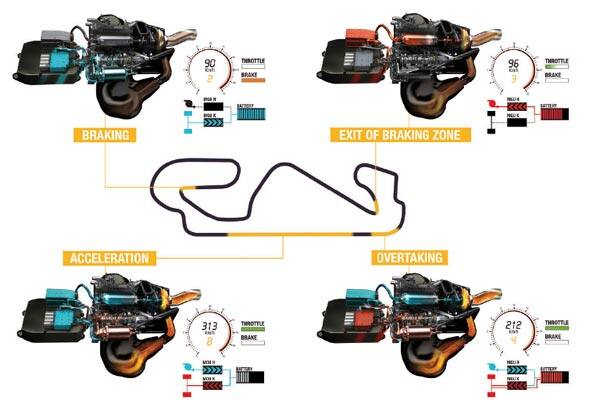Formula One will take a step into the future and embark on a new era when the first test ahead of the 2014 season gets underway at the Jerez circuit in Spain today. Force India, Williams, McLaren, Lotus, Ferrari, Sauber and Toro Rosso have already unveiled their 2014 challengers and fans will have noticed a marked difference from 2013 in the way the cars look, particularly at the front. But, in what has been hailed by some as the sport’s most sweeping rule change since its inception over six decades ago, the biggest difference lies under the skin as, keeping in step with the changing times, Formula One for the first time embraces hybrid power in a meaningful way. Here, ahead of the Jerez test, we take a look at some of the major rule changes that are expected to have a significant impact on not just the sound of Formula One but also the racing action on track. [caption id=“attachment_1361335” align=“alignleft” width=“380”]  Force India’s car for 2014. Force India[/caption] Power units: For the first time in years, engines will once again be performance differentiators. The cars will be powered by a 1.6 litre turbocharged V6 engine, smaller than the 2.4 litre naturally aspirated V8 engines in use since 2006. The engine on its own will generate about 600 horsepower but will be married to two energy recovery systems. The energy recovery systems will harness heat from the exhaust gases and the energy generated under braking and convert it to electrical energy (similar to the KERS system introduced in 2009) which can then be used to power the cars. This will generate an additional 160 horsepower which will be available to the driver for a significant 33 seconds per lap. As a result, a combination of electric energy and traditional fossil fuels will power the cars in 2014. [caption id=“attachment_1363199” align=“alignleft” width=“600”]  An example of how it all comes together (Renault engine)[/caption] In keeping with the theme of sustainability, the rules now limit the amount of fuel a car may carry over an entire race distance to 100 kilograms. There was no fuel limit in 2013 but teams typically filled cars up with about 150 kilograms of fuel for the entire race. This will make it crucial for teams to use both the energy recovery systems and the traditional internal combustion engine in tandem and strike an ideal balance between drawing power from the two. Therefore, if the energy recovery system fails, the driver will have to immediately start saving fuel – as that will be the only source now powering the car – to make it to the end of the race. As a result, reliability will be key and the regulations in this regard have also been tightened. Each driver is restricted to five whole power units in a season down from the eight engines that could be used over a season last year. A single power unit is made up of six different components and a driver may use these components in any combination he likes so long as he doesn’t use more than five of any particular component. The web of penalties that a driver can be slapped with if he exceeds the restrictions is rather complex but to put it simply, if a driver uses a sixth complete power unit he will have to start the race from the pitlane. As a result, reliability could well make or break a team’s title tilt in 2014 and the onus in the early part of the season will be on finishing races and racking up the points. In fact, Autosport recently quoted an unnamed team boss as saying that the Jerez test would be a “bloodbath” while Red Bull team boss Christian Horner also went so far as to say that half the field could retire from the season-opening race. Aerodynamics: In addition to the radically different engine regulations, rules governing aerodynamics have also been tweaked significantly, though not as drastically as those that apply to the engines. Probably the most noticeable changes visually are the new noses which in several cases consist of a proboscis-like tip jutting out the front of the chassis. This is because the height of the nose has been lowered significantly to prevent cars being launched into the air should they collide with the back of another car, and the awkward-looking design aerodynamicists have opted for is an illustration of the trade-off between safety and aerodynamic performance. Aerodynamicists want to get as much air under the chassis as possible and the tube-like nose jutting out of the chassis meets the height restrictions while being narrow enough to allow air to flow around it and get under the car. Apart from the lower noses, the front wing will also be narrower this year. Introduced in 2009, the wide front wing spanned the width of the car, extending as far out as the outer edges of the front tyres. This year, the front wing will be brought back in in front of the tyres as a result of which the edges of the front wing will be more aggressively curved as designers find a way to guide the airflow coming off the front wing around the tyres and to the rest of the car. Probably the most significant regulation change governing aerodynamics, however, is the requirement for the exhaust outlet to exit centrally behind the rear axle of the car. In 2013, the exhaust outlets were located at the rear of the sidepods on either side of the engine cover so teams could divert the flow of the gases towards the floor of the car to generate additional downforce, or grip, which made a car more stable at the rear, especially through the faster corners, allowing cars to drive through corners at higher speeds. It was something Red Bull perfected and was key to their dominance over the last few years, but with the exhaust now exiting centrally and behind the rear axle, this will no longer be possible.
But in what has been hailed by some as the sport’s most sweeping rule change since its inception over six decades ago, the biggest difference lies under the skin as Formula One for the first time embraces hybrid power in a meaningful way.
Advertisement
End of Article
Written by Abhishek Takle
Abhishek has only one passion in life. Formula One. He watched his first race on television way back in the mid-nineties with his father and since then has been absolutely hooked. In his early teens, he harboured dreams of racing in the top flight of motorsport, fighting wheel-to-wheel with the likes of Schumacher, Hill and Hakkinen but when it became evident that he didn't quite have the talent to cut it in go karts, let alone Formula One, he decided to do the next best thing - write about the sport. Abhishek is happiest when there's a race on television or when he's indulging in his F1 fantasies on the PlayStation. see more


)
)
)
)
)
)
)
)
)



